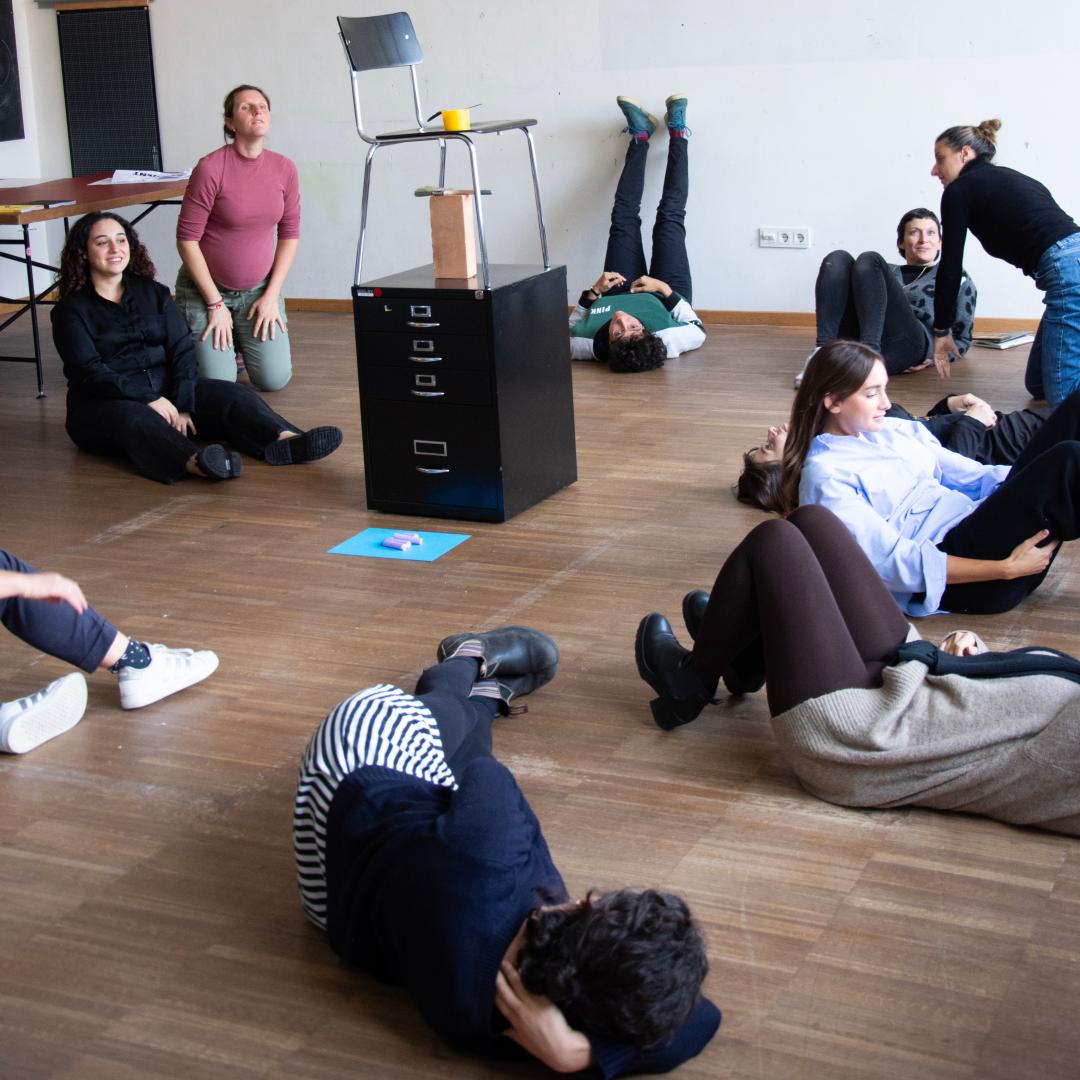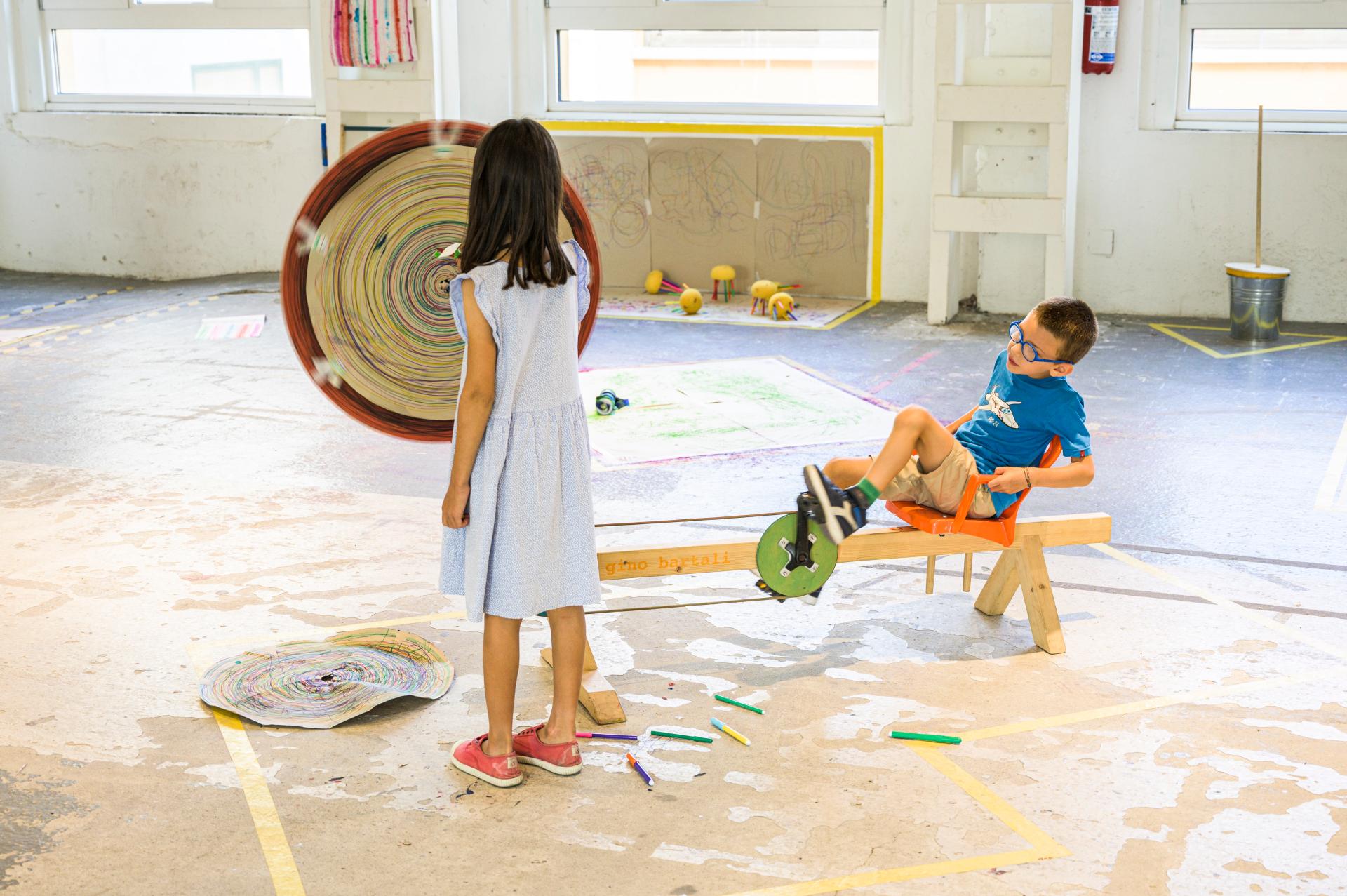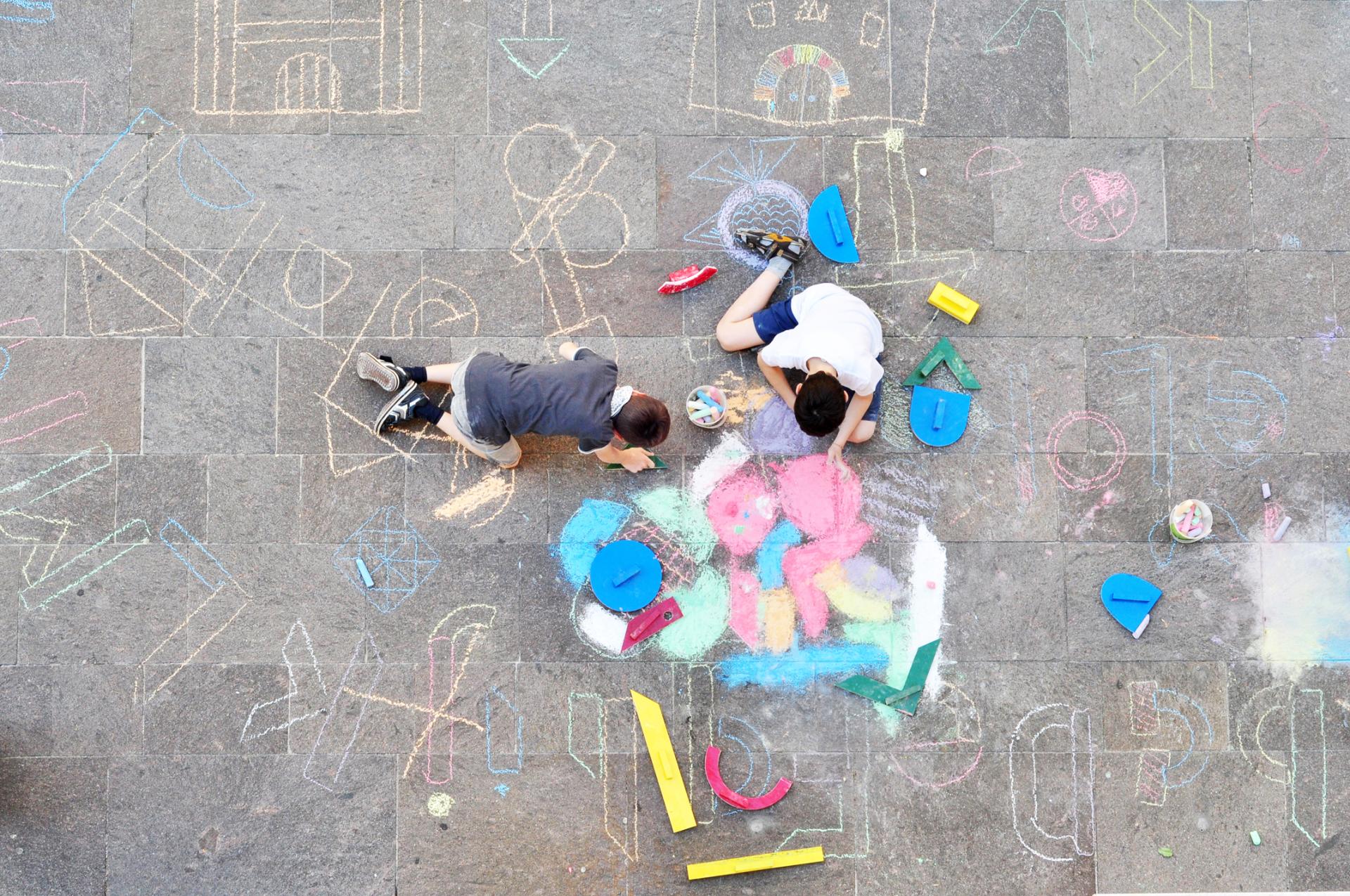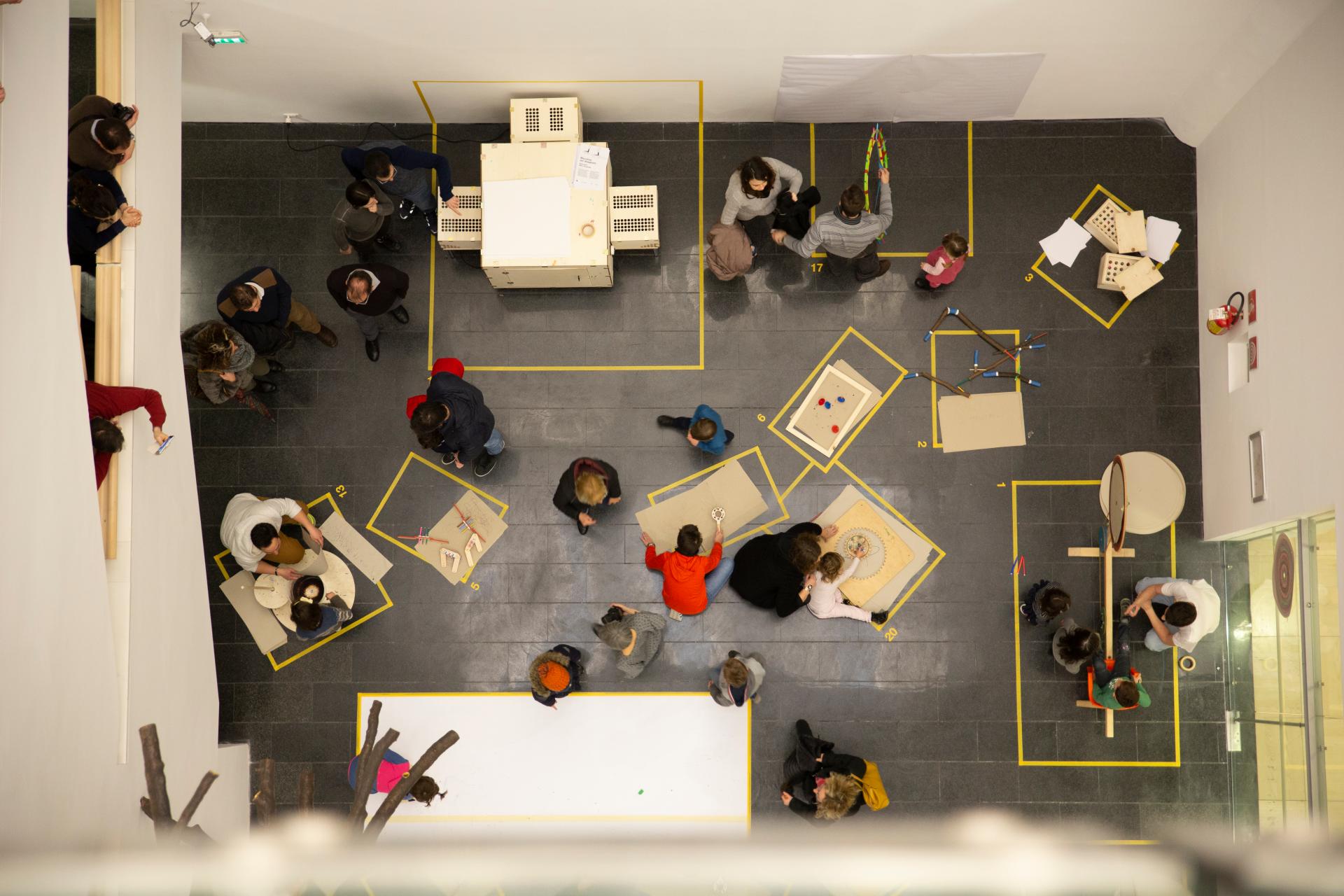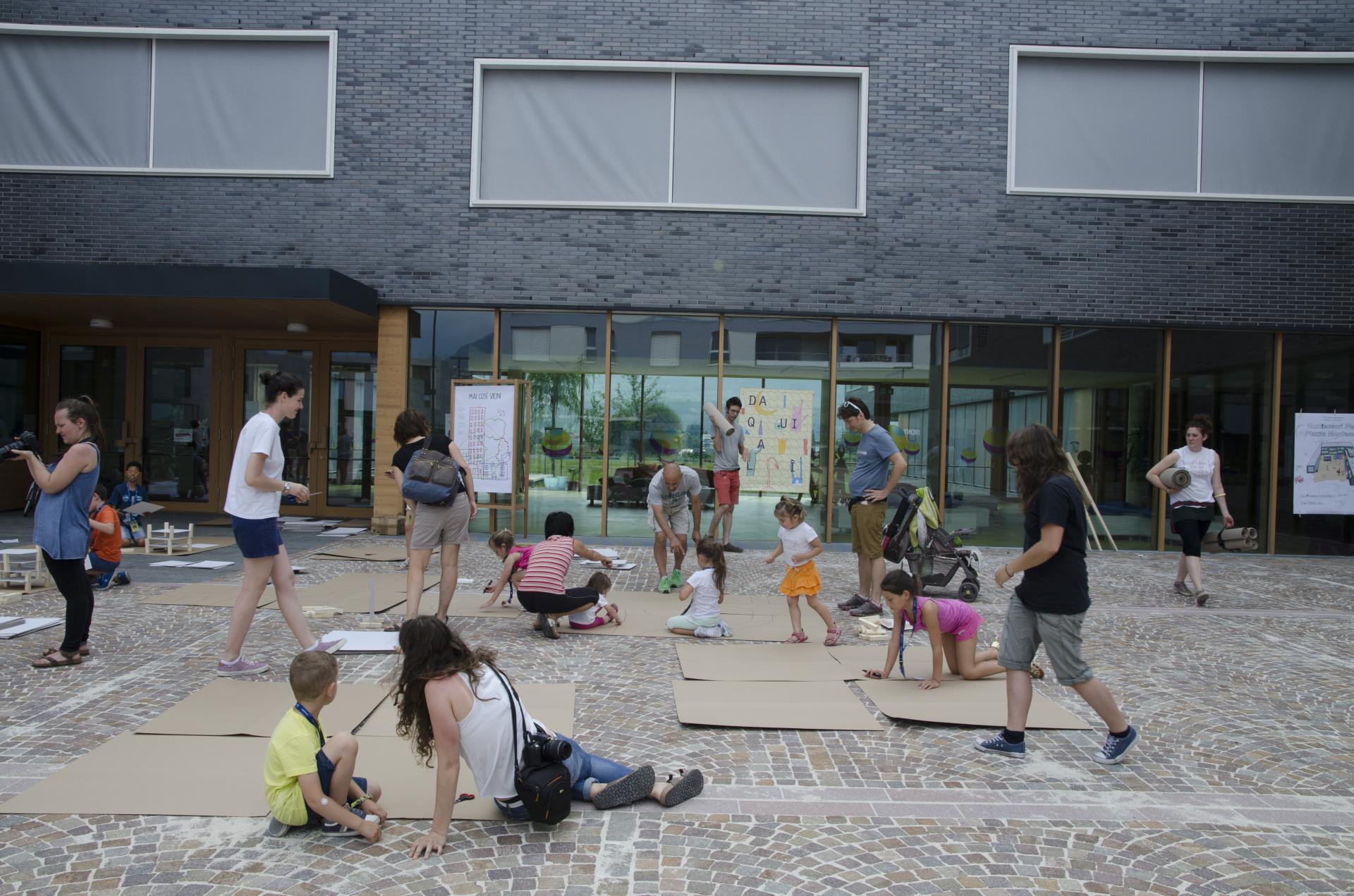Design for Children
Basic information
Project Title
Design for Children
Full project title
Master in Design for Children: objects, spaces, experiences and processes
Category
Regaining a sense of belonging
Project Description
The Master in Design for Children is a joint project of the Faculty of Design & Arts and the Faculty of Education of the Free University of Bozen-Bolzano (Italy). Our aim is to train professionals that co-design together with children and the local community innovative educational tools, practices, models and learning experiences in order to create sustainable and inspiring places that are inclusive ways for staying together.
Geographical Scope
National
Project Region
Italy
Urban or rural issues
It addresses urban-rural linkages
Physical or other transformations
It refers to other types of transformations (soft investment)
EU Programme or fund
No
Description of the project
Summary
The Master in Design for Children is a collaborative initiative between the Faculty of Design & Arts and the Faculty of Education at the Free University of Bozen-Bolzano in Italy. Our primary objective is to equip students and professionals with a comprehensive skill set, knowledge base, and practical expertise that integrates design and pedagogy. Our focus is on supporting educational processes tailored to children, particularly those aged between 6 and 10 years, while also encompassing other age groups.
The overarching goal of our program is to cultivate professionals who engage in co-design practices with children and local communities. This collaboration aims to generate innovative educational tools, practices, models, and learning experiences. The ultimate aim is to establish sustainable and inspiring environments that foster inclusivity and shared experiences. The Master Design for Children serves as a local hub that actively involves diverse stakeholders in a range of initiatives. These endeavors aim to address societal needs, produce solutions, and foster community building.
Complementary to the master project, several sub-initiatives dedicated to the local community have been instituted. These include events for children under the banner "Come on kids!," conferences for experts titled "Get curious!," informative Virtual dialogues on Design and Education accessible through our public YouTube channel, as well as projects such as "Drawing machines" and "Play with clima."
We firmly believe that replicating the successful practices of the Master Design for Children in other EU States, establishing them as local strategic hubs, could catalyze the formation of a European Network of Co-Design and Education. Such an initiative has the potential to make a significant contribution to revitalizing a sense of belonging within the European Educating Community, aligning with the core principles and spirit of the New European Bauhaus.
The overarching goal of our program is to cultivate professionals who engage in co-design practices with children and local communities. This collaboration aims to generate innovative educational tools, practices, models, and learning experiences. The ultimate aim is to establish sustainable and inspiring environments that foster inclusivity and shared experiences. The Master Design for Children serves as a local hub that actively involves diverse stakeholders in a range of initiatives. These endeavors aim to address societal needs, produce solutions, and foster community building.
Complementary to the master project, several sub-initiatives dedicated to the local community have been instituted. These include events for children under the banner "Come on kids!," conferences for experts titled "Get curious!," informative Virtual dialogues on Design and Education accessible through our public YouTube channel, as well as projects such as "Drawing machines" and "Play with clima."
We firmly believe that replicating the successful practices of the Master Design for Children in other EU States, establishing them as local strategic hubs, could catalyze the formation of a European Network of Co-Design and Education. Such an initiative has the potential to make a significant contribution to revitalizing a sense of belonging within the European Educating Community, aligning with the core principles and spirit of the New European Bauhaus.
Key objectives for sustainability
The Master in Design for Children meets sustainability criteria by training professionals to engage in co-design processes with children and local communities. This involves developing innovative educational tools, practices, models, and learning experiences to establish sustainable and inclusive environments for communal engagement. Our interpretation of the fundamental concept of "education" emphasizes fostering harmony with nature, the environment, and our planet.
In our perspective, education entails teaching children the art of inquiry, cultivating curiosity, and discovering the wonders of the world around us. This approach activates our innate instinct to care for the environment. We believe that to enhance the well-being and health of current and future generations, it is imperative to inform and educate children and society about the intricate complexities, interconnections, and circuits of crucial phenomena such as climate change, biodiversity, responsible resource management, water and air conservation, the positive implications of repairing, recycling, and reusing materials, as well as issues related to food availability, cleaner energy, and shared public transportation.
Our objective extends beyond individual education; we aim to equip professionals to educate children, their families, and society on envisioning a sustainable, inclusive, and aesthetically pleasing future. This is considered a collective responsibility. Through collaborative exploration, we seek to define new paradigms of sustainability, examining its contemporary meanings and implications for the future. Our collective efforts are directed towards providing innovative responses to societal needs and generating sustainable solutions.
Additionally, we emphasize our "Play with clima" project within this context. This initiative involves the creation of games and urban playgrounds designed to communicate and raise awareness about the rapid developments in climate change.
In our perspective, education entails teaching children the art of inquiry, cultivating curiosity, and discovering the wonders of the world around us. This approach activates our innate instinct to care for the environment. We believe that to enhance the well-being and health of current and future generations, it is imperative to inform and educate children and society about the intricate complexities, interconnections, and circuits of crucial phenomena such as climate change, biodiversity, responsible resource management, water and air conservation, the positive implications of repairing, recycling, and reusing materials, as well as issues related to food availability, cleaner energy, and shared public transportation.
Our objective extends beyond individual education; we aim to equip professionals to educate children, their families, and society on envisioning a sustainable, inclusive, and aesthetically pleasing future. This is considered a collective responsibility. Through collaborative exploration, we seek to define new paradigms of sustainability, examining its contemporary meanings and implications for the future. Our collective efforts are directed towards providing innovative responses to societal needs and generating sustainable solutions.
Additionally, we emphasize our "Play with clima" project within this context. This initiative involves the creation of games and urban playgrounds designed to communicate and raise awareness about the rapid developments in climate change.
Key objectives for aesthetics and quality
The Master in Design for Children successfully aligns with criteria pertaining to aesthetics and the quality of experiential learning, as it integrates the aesthetic dimension within the realm of design education. Emphasizing the importance of aesthetics, the program seeks to elevate positive emotions within children's learning processes by training professionals capable of designing educational objects, tools, environments, and workshop activities that exhibit beauty and aesthetic appeal. This emphasis extends to meticulous attention to details, overall structural coherence, visual appeal, affordability, functionality, material selection, and form.
Furthermore, our program places a significant emphasis on cultivating an awareness among professionals regarding the intrinsic aesthetic value inherent in education. This holistic approach encourages individuals to perceive and acquire knowledge through all senses, recognizing that the beauty of the environment contributes to enhanced cognitive engagement. Recognizing and appreciating the beauty around us can lead to the emergence of new perspectives and ideas.
Educational processes, as facilitated by our master's program, aim to stimulate discovery, instill a sense of wonder about the natural world, promote curiosity and inquiry, interpret interconnections, and encourage reflection on our environment. The goal is to foster an appreciation for the beauty that surrounds us. Our master's students are trained to develop co-designed tools, spaces, and activities that enhance critical thinking and raise awareness about the consequences of human impact on nature. This, in turn, inspires children and citizens to protect, cherish, and emulate what they perceive as beautiful, ethically sound, and conducive to an improved way of life.
In the context of this philosophy, we highlight our "Drawing Machines" project. Designed artifacts support and encourage children to engage in drawing processes in a playful ways.
Furthermore, our program places a significant emphasis on cultivating an awareness among professionals regarding the intrinsic aesthetic value inherent in education. This holistic approach encourages individuals to perceive and acquire knowledge through all senses, recognizing that the beauty of the environment contributes to enhanced cognitive engagement. Recognizing and appreciating the beauty around us can lead to the emergence of new perspectives and ideas.
Educational processes, as facilitated by our master's program, aim to stimulate discovery, instill a sense of wonder about the natural world, promote curiosity and inquiry, interpret interconnections, and encourage reflection on our environment. The goal is to foster an appreciation for the beauty that surrounds us. Our master's students are trained to develop co-designed tools, spaces, and activities that enhance critical thinking and raise awareness about the consequences of human impact on nature. This, in turn, inspires children and citizens to protect, cherish, and emulate what they perceive as beautiful, ethically sound, and conducive to an improved way of life.
In the context of this philosophy, we highlight our "Drawing Machines" project. Designed artifacts support and encourage children to engage in drawing processes in a playful ways.
Key objectives for inclusion
The Master in Design for Children has successfully met the criteria of inclusion, guided by our interpretation that "education" entails broadening our perspectives and minds to embrace enriching experiences that facilitate personal growth and transcend boundaries. More than a mere university study program, the Master in Design for Children represents a co-designed space that incorporates diverse thematic areas, methodologies, and modes of communication and output production.
Our students actively engage in the co-design process with children and various stakeholders to develop educational tools, practices, models, and learning experiences. While the primary target demographic comprises children aged 6-10, our objective is to involve their families, as well as intergenerational and intercultural audiences, encompassing society as a whole. Our approach integrates methodologies from both the design and pedagogy disciplines.
The utilization of visual communication as a universal language proves invaluable in fostering intercultural understanding. Project-based learning serves as a teaching methodology that not only supports educational processes but also cultivates skills in dialogue, negotiation, and teamwork. The overarching goal is to shape children into citizens with a democratic, socially responsible attitude that respects, safeguards, and promotes diversity.
Educational spaces, workshop activities, and community events contribute to social cohesion and cultural inclusion, emphasizing both individual and collective well-being. These initiatives have evolved into shared, participative, and inclusive forms of communal engagement. Through our endeavors, we have observed that envisioning future scenarios together and sharing worldviews strengthen the sense of community belonging.
Within this context, we underscore our collaboration on the project 'E se diventi farfalla' (And if you become a butterfly), promoted by the Centro Zaffiria in Rimini, Italy—a cultural and
Our students actively engage in the co-design process with children and various stakeholders to develop educational tools, practices, models, and learning experiences. While the primary target demographic comprises children aged 6-10, our objective is to involve their families, as well as intergenerational and intercultural audiences, encompassing society as a whole. Our approach integrates methodologies from both the design and pedagogy disciplines.
The utilization of visual communication as a universal language proves invaluable in fostering intercultural understanding. Project-based learning serves as a teaching methodology that not only supports educational processes but also cultivates skills in dialogue, negotiation, and teamwork. The overarching goal is to shape children into citizens with a democratic, socially responsible attitude that respects, safeguards, and promotes diversity.
Educational spaces, workshop activities, and community events contribute to social cohesion and cultural inclusion, emphasizing both individual and collective well-being. These initiatives have evolved into shared, participative, and inclusive forms of communal engagement. Through our endeavors, we have observed that envisioning future scenarios together and sharing worldviews strengthen the sense of community belonging.
Within this context, we underscore our collaboration on the project 'E se diventi farfalla' (And if you become a butterfly), promoted by the Centro Zaffiria in Rimini, Italy—a cultural and
Results in relation to category
The Master in Design for Children is a pilot project of the Free University of Bozen-Bolzen for a new and innovative study program that embraces the disciplines design and pedagogy. The first two editions of the one-year master have already been successfully concluded, the third edition is currently in progress. We received a really positive feedback from the students of the master, reporting that it was an enriched experience in which you get an incredible number of ideas, impulses and experiences in a very short time and can try things out endlessly in a learning processes and environment. We receive positive feedback also from the other experts, researchers and colleagues teaching in the master, from the children and parents who participate in the activities that we have organized and from the local community that have support and trust in this project. Through our participation to the NEB Prize 2024 we hope that our project Master in Design for Children could receive the proper institutional recognition and become a structured study program not only within our university, but also at national and European level. Furthermore, through our application, we want to express our will to promote the project on an international level and to support other universities, research centers and/or educational institutions to replicate our experience in other regions. The implementation of local trigger hubs in other EU States supports the development of a European Network of Co-Design and Education and leads to regain a new sense of belonging of a European Co-Designed Educating Community.
How Citizens benefit
The Master in Design for Children significantly contributes to the re-establishment of a renewed sense of community belonging, aligning with the core principles and ethos of the NEB. Its overarching objective is to train professionals capable of educating children, their families, and society at large on envisioning a sustainable, inclusive, and aesthetically pleasing future—a collective responsibility. Children, in this context, necessitate the support of an entire community for their education, fostering a reciprocal growth where the community evolves alongside them. The community is positioned not merely as an educator of the adults of tomorrow but also as a recipient of education and transformation from the children.
Students in the master's program undergo training to collaboratively design a diverse array of materials, tools, and learning methods with children, aiming to inspire diverse audiences. The ultimate beneficiaries of these co-designed outputs encompass children, their families, citizens, and civil society as a whole. Co-designed educational tools serve to render invisible phenomena visible, simplify complex concepts, and make knowledge accessible to all. This playful approach invites citizens and civil society to rediscover their innate curiosity, marvel at their surroundings, and gain a deeper understanding of the environment, thereby fostering a renewed sense of belonging and increased care for it.
The transformation of learning environments extends beyond formal educational settings, encompassing museums, libraries, theaters, playgrounds, and urban spaces. These tangible examples illustrate how civil society is directly impacted by the initiative. Additionally, through the deployment of diverse communication channels, both in-person and virtually, and the dissemination of research products, as well as the organization of exhibitions, events, and conferences, citizens can derive substantial benefits from the outputs of the master.
Students in the master's program undergo training to collaboratively design a diverse array of materials, tools, and learning methods with children, aiming to inspire diverse audiences. The ultimate beneficiaries of these co-designed outputs encompass children, their families, citizens, and civil society as a whole. Co-designed educational tools serve to render invisible phenomena visible, simplify complex concepts, and make knowledge accessible to all. This playful approach invites citizens and civil society to rediscover their innate curiosity, marvel at their surroundings, and gain a deeper understanding of the environment, thereby fostering a renewed sense of belonging and increased care for it.
The transformation of learning environments extends beyond formal educational settings, encompassing museums, libraries, theaters, playgrounds, and urban spaces. These tangible examples illustrate how civil society is directly impacted by the initiative. Additionally, through the deployment of diverse communication channels, both in-person and virtually, and the dissemination of research products, as well as the organization of exhibitions, events, and conferences, citizens can derive substantial benefits from the outputs of the master.
Physical or other transformations
It refers to other types of transformations (soft investment)
Innovative character
The Master in Design for Children represents a collaborative venture between the Faculty of Design & Arts and the Faculty of Education at the Free University of Bozen-Bolzano (Italy). This innovative first-level master's program integrates the disciplines of design and pedagogy, addressing the imperative need to revitalize learning methodologies and tools within educational environments, while also responding to the evolving expectations placed on the realm of research and university teaching by educational institutions.
Conceived with the goal of furnishing students and professionals with the capabilities to make substantial and groundbreaking contributions to the field, the program seeks to cultivate individuals with a unique skill set that bridges design and pedagogy. The emphasis is on developing comprehensive knowledge and practical expertise that can bridge the gap between formal learning, characteristic of institutional educational settings, and less formal environments. Targeting students and professionals already engaged in design, education, and mediation, the master's program is open to individuals with diverse educational backgrounds, encompassing designers, educators, teachers, mediators, museum educators, and professionals specializing in various sectors catering to children (e.g., publishing, crafts, design exhibits, staging, tourism, and event management).
The program stands out as one of the pioneering interdisciplinary, postgraduate educational experiences globally. It provides a platform for collaborative exploration, wherein innovative design practices and research into novel educational models converge to equip students and professionals from diverse subject areas. The overarching aim is to foster a shared commitment to discovering new pathways for engaging in the field of education and training.
Conceived with the goal of furnishing students and professionals with the capabilities to make substantial and groundbreaking contributions to the field, the program seeks to cultivate individuals with a unique skill set that bridges design and pedagogy. The emphasis is on developing comprehensive knowledge and practical expertise that can bridge the gap between formal learning, characteristic of institutional educational settings, and less formal environments. Targeting students and professionals already engaged in design, education, and mediation, the master's program is open to individuals with diverse educational backgrounds, encompassing designers, educators, teachers, mediators, museum educators, and professionals specializing in various sectors catering to children (e.g., publishing, crafts, design exhibits, staging, tourism, and event management).
The program stands out as one of the pioneering interdisciplinary, postgraduate educational experiences globally. It provides a platform for collaborative exploration, wherein innovative design practices and research into novel educational models converge to equip students and professionals from diverse subject areas. The overarching aim is to foster a shared commitment to discovering new pathways for engaging in the field of education and training.
Disciplines/knowledge reflected
The Master in Design for Children is primarily grounded in the interdisciplinary realms of design and pedagogy, representing the realization of an innovative professional archetype necessitating specialized skills, knowledge, and expertise. The formulation of the master's curriculum was preceded by a comprehensive three-year research initiative titled "EDDES: Education through/with design." This collaborative project involved researchers from the Faculty of Design & Arts and the Faculty of Education at the Free University of Bozen-Bolzano (Italy), alongside experts from the professional field. The primary objective was to explore the dynamic interaction between these two disciplines (https://eddes.unibz.it).
Historically, initial reflections on the intersection of pedagogy and design can be traced in the works and philosophies of influential figures in both fields. Notable educators such as Maria Montessori, Friedrich Fröbel, Giuseppina Pizzigoni, and distinguished designers including Bruno Munari, Enzo Mari, and others have contributed to these early discussions. A more structured examination of the connection between design, pedagogy, and education gained prominence through the exhibition 'Century of the Child: Growing by Design, 1900-2000,' curated by Juliet Kinchin at the MoMA in New York in 2012. At the national level, a similar exploration was undertaken in the exhibition 'Giro Giro Tondo. Design for Children,' curated by Silvana Annichiaro with graphic and exhibition design by Giorgio Camuffo. This exhibition was showcased during the 10th edition of the Triennale Design Museum in Milan in 2017-18.
The Master in Design for Children signifies the culmination of a rigorous academic curriculum at the highest university level, dedicated to the training of professionals operating at the intersection of design and pedagogy.
Historically, initial reflections on the intersection of pedagogy and design can be traced in the works and philosophies of influential figures in both fields. Notable educators such as Maria Montessori, Friedrich Fröbel, Giuseppina Pizzigoni, and distinguished designers including Bruno Munari, Enzo Mari, and others have contributed to these early discussions. A more structured examination of the connection between design, pedagogy, and education gained prominence through the exhibition 'Century of the Child: Growing by Design, 1900-2000,' curated by Juliet Kinchin at the MoMA in New York in 2012. At the national level, a similar exploration was undertaken in the exhibition 'Giro Giro Tondo. Design for Children,' curated by Silvana Annichiaro with graphic and exhibition design by Giorgio Camuffo. This exhibition was showcased during the 10th edition of the Triennale Design Museum in Milan in 2017-18.
The Master in Design for Children signifies the culmination of a rigorous academic curriculum at the highest university level, dedicated to the training of professionals operating at the intersection of design and pedagogy.
Methodology used
The interdisciplinary Master in Design for Children seamlessly integrates the disciplines of design and pedagogy, necessitating a multifaceted research approach. The pedagogical framework of the study program is bifurcated, with approximately half of the sessions focusing on theoretical foundations and the remaining sessions adopting a more project-oriented and practical approach. The diverse nature of the involved disciplines necessitates the utilization of varied research methods and approaches, contingent upon the specific focus of the research question and the objectives of the project.
In formulating the master's curricula, a central method employed was the design project method. This approach commenced with the delineation of fundamental competencies requisite for engaging in the field of design for children. Subsequently, the study plan was articulated through the selection of content that concretized and presented the final study curriculum for the master's program. Since the program's inception, a series of initiatives and research projects have been initiated, employing diverse research methods. The amalgamation of deductive and inductive approaches converges in the execution of projects manifested as products, tools, practices, and educational experiences.
Both design and education, as relational disciplines, involve the negotiation of concepts and contents across different levels of interaction. To address specific research inquiries within a broader research framework, a combination of quantitative and qualitative research methods is employed, each with its methodological advantages and drawbacks. In the realm of design for children, our research methodology incorporates participatory and co-designed research settings, qualitative semi-structured interviews, focus groups, quantitative questionnaires, anthropological observation, meta-analysis of research and collected data, evidence-based practice, and action research.
In formulating the master's curricula, a central method employed was the design project method. This approach commenced with the delineation of fundamental competencies requisite for engaging in the field of design for children. Subsequently, the study plan was articulated through the selection of content that concretized and presented the final study curriculum for the master's program. Since the program's inception, a series of initiatives and research projects have been initiated, employing diverse research methods. The amalgamation of deductive and inductive approaches converges in the execution of projects manifested as products, tools, practices, and educational experiences.
Both design and education, as relational disciplines, involve the negotiation of concepts and contents across different levels of interaction. To address specific research inquiries within a broader research framework, a combination of quantitative and qualitative research methods is employed, each with its methodological advantages and drawbacks. In the realm of design for children, our research methodology incorporates participatory and co-designed research settings, qualitative semi-structured interviews, focus groups, quantitative questionnaires, anthropological observation, meta-analysis of research and collected data, evidence-based practice, and action research.
How stakeholders are engaged
The Master in Design for Children is primarily designed for students and professionals already engaged in the domains of design, education, and mediation, seeking to expand their skill set by integrating pedagogical and design elements. The program accommodates individuals with diverse educational backgrounds, catering to designers, educators, teachers, mediators, museum educators, and professionals in various sectors specializing in products and services for children, such as publishing, crafts, design exhibits, staging, tourism, and event management.
While the primary focus is on children aged 6-10, the development of educational tools, practices, models, and experiences extends to diverse contexts, including kindergarten and day care centers, high schools, families, and society at large. Local and regional stakeholders include schools, associations, municipalities, libraries, and cultural institutions. On a broader scale, collaborations are sought at the national and European levels with other universities, research centers, museums, and entities working towards integrating design and education. The objective is to establish connections between institutions, innovative educational approaches, and best practice models.
While the primary focus is on children aged 6-10, the development of educational tools, practices, models, and experiences extends to diverse contexts, including kindergarten and day care centers, high schools, families, and society at large. Local and regional stakeholders include schools, associations, municipalities, libraries, and cultural institutions. On a broader scale, collaborations are sought at the national and European levels with other universities, research centers, museums, and entities working towards integrating design and education. The objective is to establish connections between institutions, innovative educational approaches, and best practice models.
Global challenges
The key objective of the Master Design for Children is to train professionals that co-design together with children and the local community innovative educational tools, practices, models and learning experiences with the goal to create sustainable and inspiring places that are inclusive ways for staying together. In particular, the area of the Autonomous Province of South-Tyrol has to face specific challenges since it is located at the border between Italy, Austria and Swiss and the area is characterized by a historically developed multiculturalism and trilingualism (Italian, German and Ladin) and in recent times also the number of people with a migration background has increased. Also, tourism has an important impact in the region and in the development of society. Furthermore, as a mountain region, there are different local peculiarities between the rural and the more urban landscapes. Therefore, it becomes more important to invest in the needs of children and of the local community. Through this new approach in education in which professionals co-design with the children local solutions and new attitudes could point the way also for global challenges.
Learning transferred to other parties
The Master in Design for Children represents a collaborative educational endeavor between two well-established university faculties: the Faculty of Design & Arts and the Faculty of Education. The imperative to revitalize educational tools, practices, models, and learning experiences extends beyond our immediate context, as other regions also seek innovative approaches. The program aims to train professionals who engage in co-design processes with children and local communities, fostering the creation of sustainable and inspiring environments that promote inclusivity and communal engagement.
Given the interdisciplinary nature of the master's program, which bridges design and pedagogy, it is inherently transferable and replicable to other locations, beneficiary groups, and contexts. The ease of transferability arises from the fact that the educators, experts, and researchers involved in organizing and implementing the master's program are typically already available in each university. Consequently, the requisite personnel and structural resources can be accessed without necessitating substantial financial investments.
Moreover, we posit that replicating our successful Master Design for Children experience in other EU Member States and the Western Balkans, positioning them as local strategic hubs, has the potential to catalyze the formation of a European Network of Co-Design and Education. This initiative, aligned with the core principles and ethos of the New European Bauhaus, would significantly contribute to reinvigorating a sense of belonging within the European Educating Community.
Given the interdisciplinary nature of the master's program, which bridges design and pedagogy, it is inherently transferable and replicable to other locations, beneficiary groups, and contexts. The ease of transferability arises from the fact that the educators, experts, and researchers involved in organizing and implementing the master's program are typically already available in each university. Consequently, the requisite personnel and structural resources can be accessed without necessitating substantial financial investments.
Moreover, we posit that replicating our successful Master Design for Children experience in other EU Member States and the Western Balkans, positioning them as local strategic hubs, has the potential to catalyze the formation of a European Network of Co-Design and Education. This initiative, aligned with the core principles and ethos of the New European Bauhaus, would significantly contribute to reinvigorating a sense of belonging within the European Educating Community.
Keywords
Design
Education
Children
Community
University

